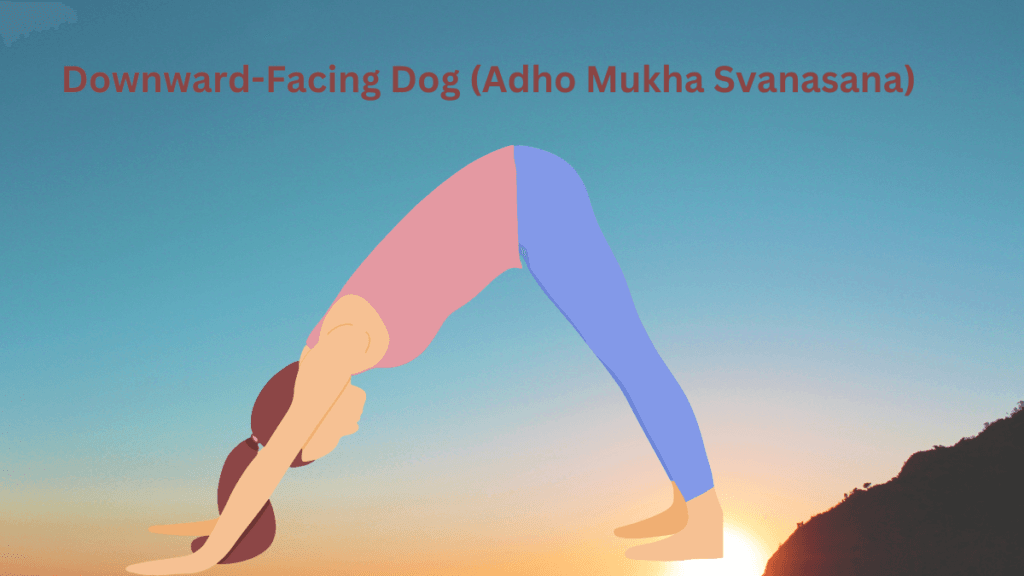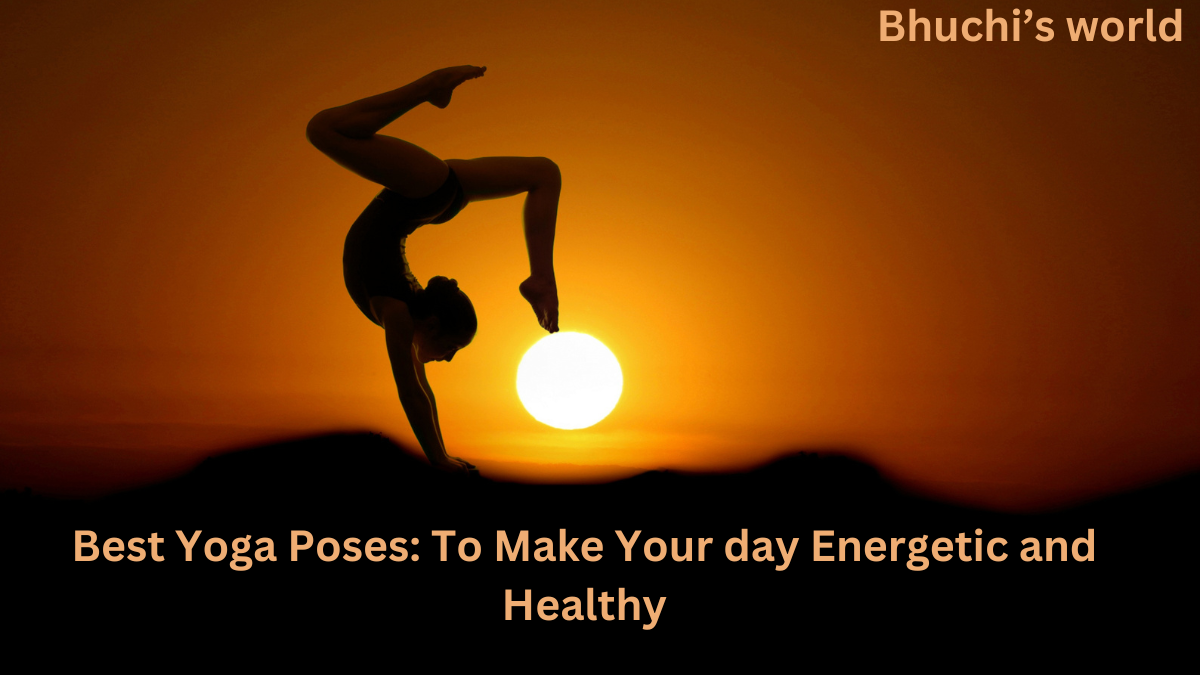In today’s fast-paced world, yoga has emerged as a sanctuary for many. It is a practice that unites the body, mind, and spirit, providing both physical and mental benefits. Whether you are a seasoned practitioner or a beginner, it is important to understand the best yoga poses in order to deepen your practice and experience all of its benefits. Below, we will explore some of the most beneficial yoga exercises for achieving balance, flexibility, strength, and inner peace, as well as reducing belly fat.
1. Downward-Facing Dog (Adho Mukha Svanasana)

Downward-Facing Dog is one of the most well-known and widely practiced poses in yoga. It serves as a cornerstone in many yoga sequences, particularly in Vinyasa and Ashtanga yoga.
How to Perform:
- Start on your hands and knees, with your wrists aligned under your shoulders and knees under your hips.
- Spread your fingers wide and press firmly through your palms.
- Tuck your toes under and slowly lift your hips towards the ceiling, straightening your legs as much as possible.
- Keep your head between your arms, with your ears aligned with your upper arms.
- Your body should form an inverted V-shape.
- Hold the pose for 5-10 breaths, focusing on your breath and the stretch along your back and legs.
Benefits:
- Strengthens the arms, shoulders, and legs.
- Stretches the hamstrings, calves, and spine.
- Relieves tension and stress, calming the mind.
- Improves circulation and energizes the body.
2. Warrior II (Virabhadrasana II)
Warrior II is a powerful pose that builds strength and stability. It’s a dynamic posture that engages multiple muscle groups and enhances focus and concentration.
How to Perform:
- Begin in Mountain Pose (Tadasana).
- Step your left foot back about 3-4 feet, turning your left foot slightly inward while keeping your right foot facing forward.
- Raise your arms parallel to the floor, palms down.
- Bend your right knee, ensuring it’s directly over your ankle, and gaze over your right hand.
- Hold the pose for 30 seconds to 1 minute, then switch sides.
Benefits:
- Strengthens the legs, ankles, and core.
- Stretches the hips, groin, and shoulders.
- Improves stamina and endurance.
- Enhances balance and stability, both physically and mentally.
3. Tree Pose (Vrksasana)
Tree Pose is a classic balancing pose that promotes focus, grounding, and mental clarity. It’s an excellent pose for cultivating a sense of inner strength and stability.
How to Perform:
- Start in Mountain Pose (Tadasana).
- Shift your weight onto your left foot and slowly lift your right foot, placing the sole against your left inner thigh or calf (avoid the knee).
- Bring your hands to your heart center in a prayer position, or extend them overhead with palms facing each other.
- Focus your gaze on a fixed point to help maintain balance.
- Hold the pose for 30 seconds to 1 minute, then switch sides.
Benefits:
- Strengthens the legs and core.
- Improves balance and stability.
- Enhances concentration and mental focus.
- Encourages a sense of grounding and inner calm.
4. Child’s Pose (Balasana)
Child’s Pose is a restorative pose that is perfect for relaxation and stress relief. It’s often used as a resting pose between more challenging postures.
How to Perform:
- Kneel on the floor, touching your big toes together and sitting back on your heels.
- Separate your knees about hip-width apart.
- Exhale and lay your torso down between your thighs.
- Extend your arms forward, palms down, or alongside your body with palms facing up.
- Rest your forehead on the mat and breathe deeply, staying in the pose for as long as needed.
Benefits:
- Stretches the back, hips, and thighs.
- Relieves tension and fatigue.
- Calms the mind and reduces stress.
- Gently opens the hips and shoulders.
5. Bridge Pose (Setu Bandhasana)
Bridge Pose is an excellent backbend that strengthens the spine and opens the chest. It’s a versatile pose that can be modified for various levels of practice.
How to Perform:
- Lie on your back with your knees bent and feet flat on the floor, hip-width apart.
- Place your arms alongside your body, palms facing down.
- Press your feet and arms into the floor as you lift your hips towards the ceiling.
- Clasp your hands under your back and press your forearms into the mat to lift your chest higher.
- Hold the pose for 30 seconds to 1 minute, then slowly lower your hips back to the floor.
Benefits:
- Strengthens the back, glutes, and hamstrings.
- Stretches the chest, neck, and spine.
- Stimulates the lungs and thyroid gland.
- Reduces anxiety, fatigue, and back pain.
6. Cobra Pose (Bhujangasana)
Cobra Pose is a gentle backbend that increases spinal flexibility and strengthens the upper body. It’s an essential pose in many yoga sequences, especially in the Sun Salutation (Surya Namaskar).
How to Perform:
- Lie face down on the mat with your legs extended and feet together.
- Place your hands under your shoulders, elbows close to your body.
- Inhale and slowly lift your chest off the floor, using your back muscles rather than pushing with your hands.
- Keep your elbows slightly bent and your shoulders away from your ears.
- Hold the pose for 15-30 seconds, then slowly lower your chest back to the floor.
Benefits:
- Strengthens the spine and opens the chest.
- Improves posture and alleviates back pain.
- Stimulates abdominal organs, improving digestion.
- Increases flexibility and reduces stress.
7. Triangle Pose (Trikonasana)
Triangle Pose is a standing pose that stretches the entire body, promoting balance and stability. It’s a fundamental pose in many yoga practices, offering a deep stretch to the legs and torso.
How to Perform:
- Stand with your feet about 3-4 feet apart.
- Turn your right foot out 90 degrees and your left foot slightly inward.
- Extend your arms parallel to the floor, palms facing down.
- Reach your right hand forward and tilt your torso to the right, lowering your hand to your shin, ankle, or the floor outside your right foot.
- Extend your left arm towards the ceiling, keeping your gaze towards your left hand.
- Hold the pose for 30 seconds to 1 minute, then switch sides.
Benefits:
- Stretches the legs, hips, and spine.
- Strengthens the knees, ankles, and core.
- Improves digestion and reduces anxiety.
- Enhances balance and concentration.
8. Seated Forward Bend (Paschimottanasana)
Seated Forward Bend is a calming pose that stretches the entire back body, from the heels to the spine. It’s an excellent pose for relieving stress and tension.
How to Perform:
- Sit on the floor with your legs extended straight in front of you.
- Inhale and lengthen your spine, reaching your arms overhead.
- Exhale and hinge at your hips, folding forward over your legs.
- Reach for your feet, ankles, or shins, keeping your spine long.
- Hold the pose for 1-3 minutes, breathing deeply and relaxing into the stretch.
Benefits:
- Stretches the hamstrings, spine, and shoulders.
- Calms the mind and reduces stress.
- Improves digestion and stimulates the liver and kidneys.
- Relieves symptoms of anxiety, fatigue, and menstrual discomfort.
9. Cat-Cow Pose (Marjaryasana-Bitilasana)
Cat-Cow Pose is a gentle flow between two poses that warms up the spine and increases flexibility. It’s often used as a preparatory sequence to awaken the body before moving into more challenging postures.
How to Perform:
- Begin on your hands and knees, with your wrists under your shoulders and knees under your hips.
- Inhale as you arch your back (Cow Pose), lifting your head and tailbone towards the ceiling.
- Exhale as you round your spine (Cat Pose), tucking your chin to your chest and drawing your belly towards your spine.
- Continue to flow between these two poses for 5-10 breaths, moving with your breath.
Benefits:
- Increases spinal flexibility and strength.
- Stimulates and massages the abdominal organs.
- Relieves tension in the neck, shoulders, and spine.
- Improves mental focus and coordination.
10. Corpse Pose (Savasana)
Corpse Pose is typically the final pose in a yoga practice, offering deep relaxation and integration of the benefits from the session. It’s a pose of surrender, where you allow your body and mind to rest completely.
How to Perform:
- Lie flat on your back with your legs extended and arms relaxed by your sides, palms facing up.
- Close your eyes and take deep, slow breaths, allowing your body to sink into the mat.
- Stay in the pose for 5-10 minutes, focusing on your breath and letting
11. Flamingo Pose (Tittibhasana Variation)
Flamingo Pose is a challenging balancing pose that combines elements of strength, flexibility, and focus. It requires both physical and mental balance, making it an advanced pose that is ideal for practitioners looking to deepen their practice.
How to Perform:
- Begin in Mountain Pose (Tadasana).
- Shift your weight onto your left foot and lift your right leg, bending your knee and bringing it towards your chest.
- Extend your right leg straight out in front of you, keeping your foot flexed.
- Simultaneously, extend your arms forward, parallel to the ground, as if reaching for your right foot.
- For an added challenge, you can bring your right hand to grasp the outer edge of your right foot, while your left arm extends back behind you, creating a “flamingo” shape with your body.
- Focus your gaze on a fixed point to maintain balance and hold the pose for 30 seconds to 1 minute.
- Slowly release the pose and repeat on the opposite side.
Benefits:
- Improves balance and coordination.
- Strengthens the legs, core, and arms.
- Enhances focus and mental clarity.
- Increases flexibility in the hamstrings and hips.
Discover more from Bhuchi's World
Subscribe to get the latest posts sent to your email.

